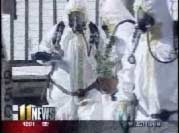 Image via Wikipedia
Image via Wikipedia
This writer has consistently argued that the prevalence of “P” in NZ is a product of a policy that delivers many unintended consequences one of which is more “P”.
It is almost a given that Carla-Louise Wallace’s seminal thesis on methamphetamine and NZ media “Menace or Moral Panic?” will not feature at tonight’s “Holmes” celebrity roast fundraiser before 300+ rich folk ($325 seat) including the Minister of Social Development, Paula Bennet and Minister of Justice, Simon Power.
Abstract: [excerpt] This thesis, presented as a collection of articles, journalistic in its tone, is titled “Menace or Moral Panic? Methamphetamine and the New Zealand Press”. Within the collection, evidence and background information is presented that supports a claim that a moral panic fitting Stanley Cohen‘s classic model occurred between 1999 and 2004.This moral panic was also identified using Stuart Hall‘s definition of a moral panic outlined in his mugging study published in 1978 as well as the more contemporary model of Goode and Ben-Yehuda (1994). Jock Young’s theory of The Deviance Amplification Spiral is also addressed and can be applied to this collection when considering the close ‘symbiotic’ relationship that our press here in New Zealand have with our police force. In looking at this particular subject it is vital that we look at how drugs and drug use play a role in the media. Also as part of the back grounding for this collection it was of critical importance to find whether a moral panic happened anywhere else in the world in relation to methamphetamine. Two previous moral panics about methamphetamine are featured in this collection as part of a case study presented in “Ancient Anecdotes meet Modernity: Drugs and the Rise of Methamphetamine” in which between the years of 1989 and 1996 America passed through two moral panics brought on to a considerable extent by a mixture of media hype and political opportunism. (snip)
The last article in this collection investigates, using expert interviews, if there is enough evidence to support the claim that methamphetamine may be a menace to New Zealand society, but that the extent of that menace may be exaggerated by a moral panic brought on by our media and fuelled by our police force. (snip)
The police as amplifiers of deviancy [J Young – Drugs and Politics, 1977 – books.google.com ] examines the reasons for police action against the drugtaker and issues of moral disturbance, disproportionality, displacement and volatility.
A recent paper by MIT’s Urban Studies and Planning, Gary T Marx citing Young on the same subject reads like an instruction manual for how to work out what went wrong in Napier placing as it does responsibility for unintended consequences, contrary to the ruling paradigm, on Policing, not just Policy.
 Image via Wikipedia
Image via Wikipedia
This evenings Sky City Stellar Trust Dinner “Roast” is just another such moral panic conveniently funding everything that has failed (Methcon, FADE, LIFE are the prime beneficiaries) and further entrenching everything that is broken. Paul Holme’s false assertion of <5% treatment success for “P” may be way off mark, but ‘the roast and its purpose’ speaks volumes. No good comes from putting labels on anyone. Least of all those on those who need help. (http://www.grownups.co.nz/read/directories/community_services_charities/stellar-trust )
The more dangerous a drug is, the more culpable a government for abrogating control to criminal networks, maximising social harm, misplacing resources and deluding themselves and everyone else. However, as this point is likely to fly over the heads of dead tree media it will be interesting to see what the Celebrity Roast’s Cellars and Bar-take is and how that might inform the real drug debate.
The MildGreens say the intersectoral social capital is in the ‘all drug’ approach as originally
 Image via Wikipedia
Image via Wikipedia
mooted in the National Drug Policy consulative phase and accepted in principle in the final drafts. The first step, the homogulation of any and all psychoactive recreational drugs safer than alcohol and tobacco (nicotine) to be placed in the October 6th 2008 regulations for sale, storage, manufacture, labeling, advertising, premises, and age of consent for [“Soft” drugs needing] effective control and emperical research. Cannabis, LSD, MDMA, Ibogaine…all administered by the Ministry of Health.
The rules are already there, so with that legislative progress one could wonder why (Health Minister) Hon Tony Ryall is avoiding a “roasting” seat tonight?
Blair Anderson ‹(•¿•)›
ph (643) 389 4065 cell 027 265 7219
Related articles by Zemanta
 Image by Getty Images via Daylife
Image by Getty Images via Daylife








